The global carboxymethyl tamarind gum market is valued at USD 18.8 million in 2025 and is slated to reach USD 34.0 million by 2035, recording an absolute increase of USD 15.2 million over the forecast period. This translates into a total growth of 81.0%, with the market forecast to expand at a compound annual growth rate (CAGR) of 6.1% between 2025 and 2035. The overall market size is expected to grow by approximately 1.81X during the same period, supported by increasing demand for natural hydrocolloid solutions, growing adoption of plant-based thickening agents across industrial applications, and rising preference for eco-friendly gelling agents in food processing and pharmaceutical formulations.
The carboxymethyl tamarind gum market represents an emerging segment of the global hydrocolloid industry, characterized by expanding applications across food processing, pharmaceutical manufacturing, and cosmetic formulations. Market dynamics are influenced by changing regulatory frameworks favoring natural additives, growing interest in plant-derived functional ingredients, and expanding research into modified polysaccharide applications in emerging industrial sectors. Traditional hydrocolloid consumption patterns are evolving as manufacturers seek specialized alternatives that offer enhanced performance characteristics and natural origin credentials.
Consumer and industrial behavior in the carboxymethyl tamarind gum market reflects broader trends toward natural ingredient sourcing, functional performance optimization, and regulatory compliance across multiple application categories. The market benefits from the growing emphasis on clean-label formulations, which are recognized for their consumer appeal and regulatory advantages in food and pharmaceutical applications. The versatility of carboxymethyl tamarind gum as both a primary functional ingredient and processing aid supports sustained demand across multiple industrial applications and formulation requirements.
Regional adoption patterns vary significantly, with Asian markets showing strong preference for tamarind-derived ingredients due to traditional familiarity and local supply advantages, while Western markets demonstrate increasing acceptance of natural hydrocolloid alternatives alongside established synthetic options. The industrial landscape continues to evolve with specialty chemical companies and natural ingredient suppliers gaining market presence in mainstream industrial channels, reflecting manufacturer willingness to invest in natural ingredient platforms for competitive differentiation.
The competitive environment features established hydrocolloid manufacturers alongside emerging specialty suppliers that focus on plant-derived modifications and application-specific formulations. Processing efficiency and supply chain reliability remain critical factors for market participants, particularly as raw material availability and processing costs continue to influence market pricing structures. Distribution strategies increasingly emphasize technical support and application development services that combine traditional ingredient supply with direct customer collaboration through specialized technical programs.
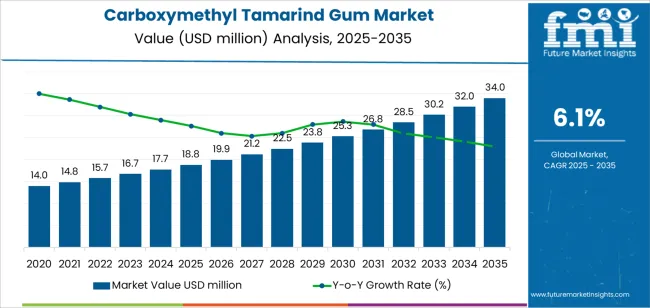
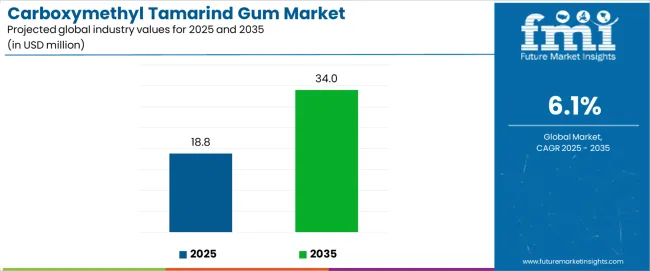
Market development trends indicate that larger chemical companies are expanding their natural ingredient portfolios through partnerships and acquisitions to access specialized markets and application expertise. Private label development has gained momentum as ingredient distributors seek to differentiate their offerings while maintaining competitive pricing in commodity hydrocolloid segments. The emergence of application-specific carboxymethyl tamarind gum grades, including high-purity pharmaceutical variants and specialized food-grade formulations, reflects changing customer requirements and creates new market opportunities for innovative suppliers. Manufacturing process improvements and quality standardization enable consistent production scaling while maintaining the functional characteristics that customers expect from natural hydrocolloid products.
Between 2025 and 2030, the carboxymethyl tamarind gum market is projected to expand from USD 18.8 million to USD 25.3 million, resulting in a value increase of USD 6.5 million, which represents 42.8% of the total forecast growth for the decade. This phase of development will be shaped by increasing adoption of natural hydrocolloid alternatives, rising demand for plant-based functional ingredients, and growing emphasis on specialized applications with enhanced performance characteristics. Chemical manufacturers are expanding their production capabilities to address the growing demand for modified natural polymers, specialty hydrocolloid products, and application-specific formulations across industrial channels.
| Metric | Value |
|---|---|
| Estimated Value (2025E) | USD 18.8 million |
| Forecast Value (2035F) | USD 34.0 million |
| Forecast CAGR (2025-2035) | 6.10% |
From 2030 to 2035, the market is forecast to grow from USD 25.3 million to USD 34.0 million, adding another USD 8.7 million, which constitutes 57.2% of the overall ten-year expansion. This period is expected to be characterized by the expansion of specialized application segments, the integration of advanced processing technologies, and the development of high-purity grades with enhanced functional properties and extended application compatibility. The growing adoption of natural ingredient processing methods will drive demand for carboxymethyl tamarind gum with superior performance characteristics and compatibility with regulatory requirements across industrial operations.
Between 2020 and 2025, the carboxymethyl tamarind gum market experienced steady development, driven by increasing demand for natural hydrocolloid alternatives and growing recognition of modified plant polymers as effective functional ingredients for specialized industrial applications across chemical processing and formulation development. The market evolved as manufacturers recognized the potential for natural hydrocolloid products to provide both performance benefits and regulatory advantages while enabling specialized application protocols. Technological advancement in natural polymer modification techniques and application development methods began emphasizing the critical importance of maintaining product consistency and functional reliability in diverse industrial environments.
Market expansion is being supported by the increasing global demand for natural hydrocolloid products and the corresponding need for plant-based functional ingredients that can provide superior performance characteristics and regulatory compliance while enabling specialized applications and enhanced processing efficiency across various industrial and commercial formulations. Modern manufacturers and chemical industry specialists are increasingly focused on implementing natural polymer solutions that can deliver consistent functional properties, minimize synthetic additive requirements, and provide reliable performance throughout complex processing workflows and diverse application environments. Carboxymethyl tamarind gum's proven ability to deliver exceptional thickening properties against conventional synthetic options, enable specialized processing applications, and support regulatory compliance protocols make it an essential ingredient for contemporary industrial and commercial operations.
The growing emphasis on clean-label formulations and natural ingredient sourcing is driving demand for carboxymethyl tamarind gum that can support large-scale industrial requirements, improve processing outcomes, and enable specialized application systems. Manufacturer preference for ingredients that combine effective functional performance with natural origin credentials and regulatory advantages is creating opportunities for innovative hydrocolloid implementations. The rising influence of environmental regulations and consumer preference trends is also contributing to increased demand for carboxymethyl tamarind gum that can provide processing benefits, natural ingredient positioning, and reliable quality across extended industrial applications.
The carboxymethyl tamarind gum market is poised for steady growth and transformation. As manufacturers across Asia-Pacific, North America, Europe, and emerging markets seek ingredients that deliver exceptional functional performance, natural origin credentials, and regulatory compliance capabilities, carboxymethyl tamarind gum is gaining prominence not just as a hydrocolloid but as a strategic enabler of natural formulation development and specialized processing applications.
Rising clean-label adoption in North America and expanding natural ingredient initiatives globally amplify demand, while manufacturers are leveraging innovations in polymer modification systems, application-specific processing methods, and specialized grade development technologies.
Pathways like pharmaceutical-grade variants, food-specific formulations, and specialized industrial solutions promise strong margin uplift, particularly in high-performance application segments. Geographic expansion and application diversification will capture volume, especially where regulatory compliance and natural ingredient positioning are critical. Regulatory support around natural ingredient classification, food safety standards, and pharmaceutical quality requirements give structural support.
The market is segmented by type, application, grade type, distribution channel, price segment, and region. By type, the market is divided into hot water soluble, cold water soluble, and modified variants categories. By application, it covers food, pharmaceutical, cosmetics and personal care, and industrial application segments. By grade type, the market includes pharmaceutical grade, food grade, and industrial grade. By distribution channel, it comprises direct sales, chemical distributors, and specialty suppliers. By price segment, the market is categorized into premium, standard, and economy categories. Regionally, the market is divided into North America, Europe, East Asia, South Asia & Pacific, Latin America, and the Middle East & Africa.
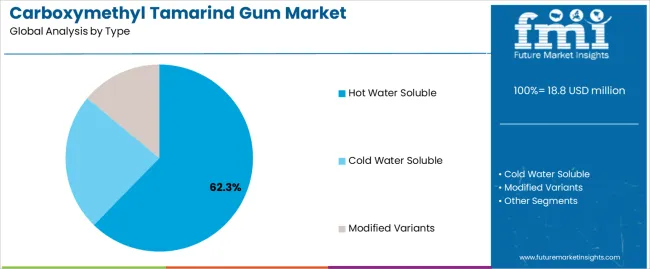
The hot water soluble segment is projected to account for 62.3% of the type tamarind gum market in 2025, reaffirming its position as the leading type category. Chemical manufacturers and processing operators increasingly utilize hot water soluble varieties for their superior dissolution characteristics when operating across diverse industrial applications, excellent processing compatibility properties, and widespread acceptance in applications ranging from food processing to pharmaceutical manufacturing operations. Hot water soluble technology's enhanced activation processes and reliable performance capabilities directly address the manufacturer requirements for consistent functionality in complex processing environments.
This type segment forms the foundation of modern hydrocolloid processing patterns, as it represents the variant with the greatest application versatility and established performance validation across multiple industrial categories and processing segments. Manufacturer investments in dissolution optimization methods and quality consistency continue to strengthen adoption among chemical processors and specialty manufacturers. With customers prioritizing processing reliability and functional consistency, hot water soluble variants align with both performance requirements and processing expectations, making them the central component of comprehensive industrial hydrocolloid strategies.
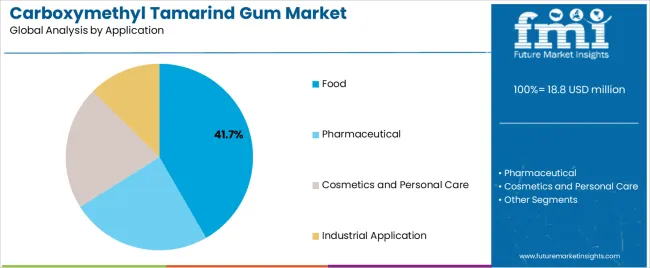
Food applications are projected to represent 41.7% of carboxymethyl tamarind gum demand in 2025, underscoring their critical role as the primary application channel for natural hydrocolloid products across food processing, formulation development, and specialty ingredient applications. Food manufacturers prefer carboxymethyl tamarind gum for their exceptional clean-label characteristics, regulatory compliance advantages, and ability to enhance product functionality while ensuring extended shelf stability throughout diverse processing conditions. Positioned as essential functional ingredients for modern food processing, carboxymethyl tamarind gum offers both performance enhancement advantages and natural positioning benefits.
The segment is supported by continuous innovation in food-grade processing technologies and the growing availability of specialized variants that enable diverse formulation requirements with enhanced functional uniformity and regulatory compliance capabilities. Food manufacturers are investing in natural ingredient platforms to support large-scale production requirements and clean-label positioning. As natural ingredient trends become more prevalent and regulatory requirements increase, food applications will continue to represent a major demand market while supporting advanced processing utilization and formulation development strategies.
The carboxymethyl tamarind gum market is advancing steadily due to increasing demand for natural hydrocolloid products and growing adoption of plant-based functional ingredients that provide superior performance characteristics and regulatory compliance while enabling specialized applications across diverse industrial and commercial formulations. The market faces challenges, including limited raw material supply sources, complex processing requirements, and the need for specialized application expertise and quality validation programs. Innovation in natural polymer modification capabilities and application-specific development systems continues to influence product advancement and market expansion patterns.
The growing adoption of clean-label formulations, natural ingredient preferences, and regulatory compliance requirements is enabling manufacturers to produce advanced carboxymethyl tamarind gum products with superior natural positioning, enhanced regulatory profiles, and proven functional capabilities. Advanced processing systems provide improved consistency while allowing more efficient production workflows and reliable quality across various industrial applications and processing conditions. Manufacturers are increasingly recognizing the competitive advantages of natural hydrocolloid capabilities for market differentiation and regulatory positioning.
Modern carboxymethyl tamarind gum producers are incorporating innovative processing technologies, application-specific modifications, and enhanced purity capabilities to improve product performance, enable specialized application formats, and deliver value-added solutions to industrial customers. These technologies improve functional reliability while enabling new market opportunities, including pharmaceutical applications, high-purity grades, and specialized processing characteristics. Advanced processing integration also allows manufacturers to support comprehensive application development systems and market expansion beyond traditional hydrocolloid approaches.
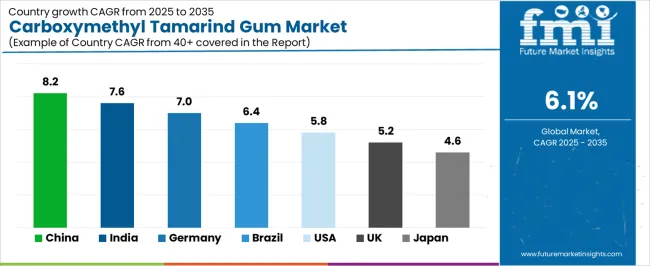
| Country | CAGR (2025 to 2035) |
|---|---|
| China | 8.2% |
| India | 7.6% |
| Germany | 7.0% |
| Brazil | 6.4% |
| United States (USA) | 5.8% |
| United Kingdom (UK) | 5.2% |
| Japan | 4.6% |
The carboxymethyl tamarind gum market is experiencing robust growth globally, with China leading at an 8.2% CAGR through 2035, driven by expanding chemical processing capabilities, growing industrial modernization programs, and significant investment in natural ingredient development technologies. India follows at 7.6%, supported by traditional tamarind processing expertise, expanding pharmaceutical manufacturing sectors, and growing modern chemical industry infrastructure. Germany shows growth at 7.0%, emphasizing advanced chemical processing innovation and specialty ingredient development. Brazil records 6.4%, focusing on expanding natural ingredient processing capabilities and industrial market development. The USA demonstrates 5.8% growth, prioritizing pharmaceutical-grade applications and specialized processing development. The UK exhibits 5.2% growth, emphasizing specialty chemical adoption and industrial innovation development. Japan shows 4.6% growth, supported by high-purity ingredient initiatives and quality-focused processing patterns.
The report covers an in-depth analysis of 40+ countries, the top-performing countries are highlighted below.
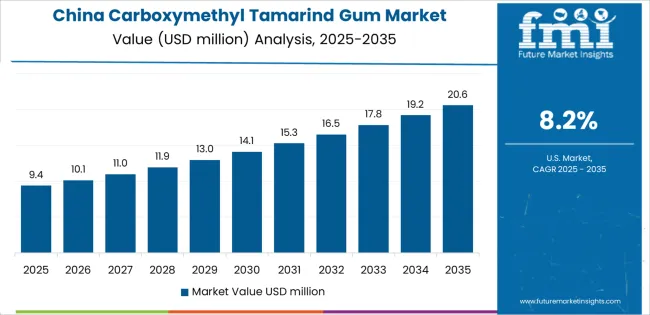
Revenue from carboxymethyl tamarind gum in China is projected to exhibit strong growth with a CAGR of 8.2% through 2035, driven by expanding chemical processing capabilities and rapidly growing industrial modernization adoption supported by manufacturing initiatives promoting natural ingredient development. The country's strong position in chemical processing advancement and increasing investment in specialty ingredient infrastructure are creating substantial demand for natural hydrocolloid products. Major chemical manufacturers and processing facilities are establishing comprehensive production capabilities to serve both domestic industrial demand and expanding export markets.
Revenue from carboxymethyl tamarind gum in India is expanding at a CAGR of 7.6%, supported by the country's traditional tamarind processing heritage, expanding pharmaceutical manufacturing sector, and increasing adoption of specialized chemical processing technologies. The country's initiatives promoting natural ingredient development and growing industrial capability are driving requirements for plant-based hydrocolloid products. International suppliers and domestic manufacturers are establishing extensive production and processing capabilities to address the growing demand for natural polymer products.
Revenue from carboxymethyl tamarind gum in Germany is expanding at a CAGR of 7.0%, supported by the country's advanced chemical processing heritage, strong emphasis on specialty ingredient innovation, and robust demand for high-quality hydrocolloid products in industrial and pharmaceutical applications. The nation's mature chemical industry sector and innovation-focused operations are driving sophisticated natural polymer varieties throughout the processing industry. Leading manufacturers and specialty processors are investing extensively in advanced processing and application development technologies to serve both domestic and international markets.
Revenue from carboxymethyl tamarind gum in Brazil is growing at a CAGR of 6.4%, driven by the country's expanding natural ingredient processing sector, growing industrial modernization programs, and increasing investment in plant-based chemical development. Brazil's large agricultural base and commitment to industrial advancement are supporting demand for diverse hydrocolloid solutions across multiple processing segments. Manufacturers are establishing comprehensive processing capabilities to serve the growing domestic market and expanding industrial opportunities.
Revenue from carboxymethyl tamarind gum in the USA is expanding at a CAGR of 5.8%, supported by the country's advanced pharmaceutical processing technology sector, strategic focus on high-purity ingredients, and established specialty chemical distribution capabilities. The USA's pharmaceutical industry leadership and specialty ingredient integration are driving demand for pharmaceutical-grade hydrocolloid varieties in medical applications, research facilities, and specialized processing applications. Manufacturers are investing in comprehensive quality systems to serve both domestic pharmaceutical markets and international specialty applications.
Revenue from carboxymethyl tamarind gum in the UK is growing at a CAGR of 5.2%, driven by the country's focus on specialty chemical advancement, emphasis on industrial innovation, and strong position in high-quality ingredient development. The UK's established chemical industry innovation capabilities and commitment to specialized processing are supporting investment in natural hydrocolloid technologies throughout major industrial regions. Industry leaders are establishing comprehensive application integration systems to serve domestic specialty applications and advanced processing requirements.
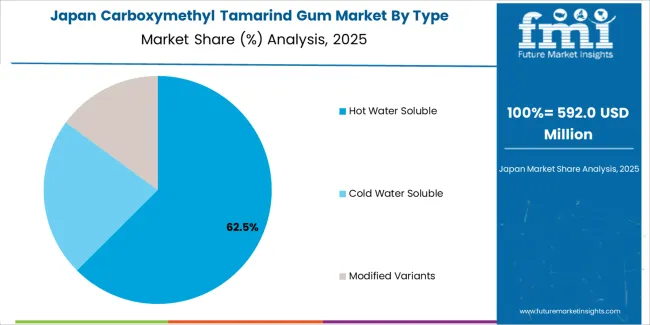
Revenue from carboxymethyl tamarind gum in Japan is expanding at a CAGR of 4.6%, supported by the country's high-purity ingredient initiatives, growing specialty chemical sector, and strategic emphasis on quality ingredient development. Japan's advanced quality control capabilities and integrated processing systems are driving demand for premium hydrocolloid products in pharmaceutical applications, specialty processing, and high-end industrial applications. Leading manufacturers are investing in specialized capabilities to serve the stringent requirements of quality-focused industries and pharmaceutical applications.
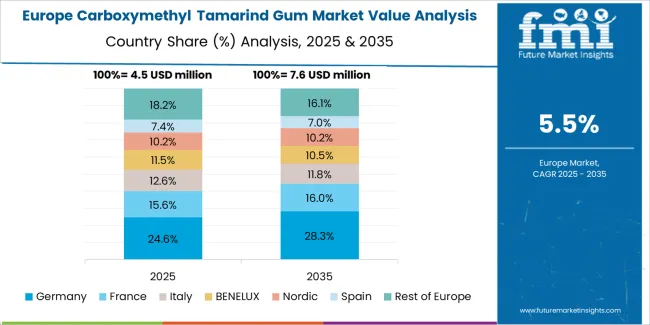
The carboxymethyl tamarind gum market in Europe is projected to grow from USD 4.2 million in 2025 to USD 7.8 million by 2035, registering a CAGR of 6.3% over the forecast period. Germany is expected to maintain its leadership position with a 42.1% market share in 2025, declining slightly to 41.7% by 2035, supported by its strong chemical processing industry, advanced specialty ingredient capabilities, and comprehensive industrial infrastructure serving diverse carboxymethyl tamarind gum applications across Europe.
France follows with a 21.4% share in 2025, projected to reach 21.8% by 2035, driven by robust demand for pharmaceutical-grade ingredients in industrial applications, specialty chemical programs, and food processing markets, combined with established chemical processing infrastructure and innovation expertise. The United Kingdom holds a 16.9% share in 2025, expected to reach 17.2% by 2035, supported by strong specialty chemical sector and growing high-purity ingredient activities. Italy commands a 9.8% share in 2025, projected to reach 10.1% by 2035, while Spain accounts for 6.2% in 2025, expected to reach 6.4% by 2035. The Netherlands maintains a 2.7% share in 2025, growing to 2.8% by 2035. The Rest of Europe region, including Nordic countries, Eastern Europe, Belgium, Poland, and other nations, is anticipated to maintain momentum, with its collective share moving from 0.9% to 0.0% by 2035, attributed to increasing industrial modernization in Eastern Europe and growing specialty ingredient penetration in Nordic countries implementing advanced processing programs.
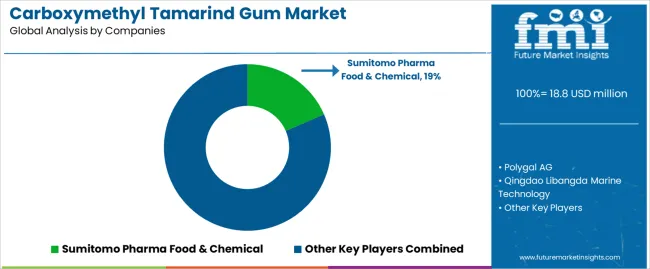
The carboxymethyl tamarind gum market is characterized by competition among established hydrocolloid manufacturers, specialty chemical producers, and integrated natural ingredient suppliers. Companies are investing in polymer modification technology research, application optimization, specialized processing system development, and comprehensive product portfolios to deliver consistent, high-quality, and application-specific carboxymethyl tamarind gum solutions. Innovation in natural polymer processing systems, purity enhancement integration, and performance optimization is central to strengthening market position and competitive advantage.
Sumitomo Pharma Food & Chemical leads the market with 19% share, offering comprehensive pharmaceutical-grade hydrocolloid solutions including advanced processing and quality control systems with a focus on medical and specialty applications. Polygal AG provides specialized natural polymer varieties with an emphasis on industrial applications and advanced processing technologies. Qingdao Libangda Marine Technology delivers comprehensive marine-derived ingredient solutions with a focus on natural polymer platforms and specialized processing services. Premcem Gums specializes in industrial hydrocolloid products and application-specific formulations for processing applications. Dabur India Ltd focuses on traditional natural ingredient processing and established supply chain capabilities. Mysore Starch Manufacturing Company offers specialized starch-based products with emphasis on natural ingredient processing and industrial applications.
| Item | Value |
|---|---|
| Quantitative Units | USD 18.8 million |
| Type | Hot Water Soluble; Cold Water Soluble; Modified Variants |
| Application | Food; Pharmaceutical; Cosmetics and Personal Care; Industrial Application |
| Grade Type | Pharmaceutical Grade; Food Grade; Industrial Grade |
| Distribution Channels | Direct Sales; Chemical Distributors; Specialty Suppliers |
| Price Segment | Premium; Standard; Economy |
| End-Use Sector | Chemical Manufacturers; Pharmaceutical Companies; Food Processors; Cosmetic Manufacturers |
| Regions Covered | North America; Europe; East Asia; South Asia & Pacific; Latin America; Middle East & Africa |
| Countries Covered | China; India; Germany; Brazil; United States; United Kingdom; Japan; and 40+ additional countries |
| Key Companies Profiled | Sumitomo Pharma Food & Chemical; Polygal AG; Qingdao Libangda Marine Technology; Premcem Gums; Dabur India Ltd; Mysore Starch Manufacturing Company |
| Additional Attributes | Dollar sales by type and application category; regional demand trends; competitive landscape; technological advancements in polymer modification systems; specialized processing development; application innovation; industrial distribution integration |
The global carboxymethyl tamarind gum market is estimated to be valued at USD 18.8 million in 2025.
The market size for the carboxymethyl tamarind gum market is projected to reach USD 34.0 million by 2035.
The carboxymethyl tamarind gum market is expected to grow at a 6.1% CAGR between 2025 and 2035.
The key product types in carboxymethyl tamarind gum market are hot water soluble, cold water soluble and modified variants.
In terms of application, food segment to command 41.7% share in the carboxymethyl tamarind gum market in 2025.






Full Research Suite comprises of:
Market outlook & trends analysis
Interviews & case studies
Strategic recommendations
Vendor profiles & capabilities analysis
5-year forecasts
8 regions and 60+ country-level data splits
Market segment data splits
12 months of continuous data updates
DELIVERED AS:
PDF EXCEL ONLINE
Carboxymethyl Cellulose Market 2024-2034
Enzymatically Hydrolyzed Carboxymethyl Cellulose Market
Tamarind Extract Market Analysis – Trends & Forecast 2024-2034
Gummed Tape Market Size and Share Forecast Outlook 2025 to 2035
Gummy Supplements Market Size and Share Forecast Outlook 2025 to 2035
Gum Arabic Market Analysis – Size, Share, and Forecast Outlook 2025 to 2035
Gummy Market Analysis by Product, Ingredient, End-Use, Distribution Channel, and Region - Forecast through 2025 to 2035
Gum Turpentine Oil Market Growth - Trends & Forecast 2025 to 2035
Gum Hydrocolloid Market Analysis by Product Type, Source, and Region through 2035
Key Companies & Market Share in the Gummed Tape Sector
Evaluating Gum Fiber Market Share & Provider Insights
Gum Rosin Market Size & Demand Analysis 2024-2034
Gum Content Tester Market
CBD Gummies Market Analysis - Size, Share and Forecast Outlook 2025 to 2035
Pre-Gummed Labels Market Growth - Demand & Forecast 2025 to 2035
Tara Gum Market Size and Share Forecast Outlook 2025 to 2035
Guar Gum Market Growth & Demand Forecast 2024-2034
Sleep Gummy Market Analysis by Primary Ingredient, Customer Orientation, Pack Size and Product Claim Through 2035
Paper Gummed Tape Market Growth - Demand & Forecast 2025 to 2035
CoQ10 Gummies Market Analysis by Source, Distribution Channels, and Key Regions Through 2035

Thank you!
You will receive an email from our Business Development Manager. Please be sure to check your SPAM/JUNK folder too.
Chat With
MaRIA